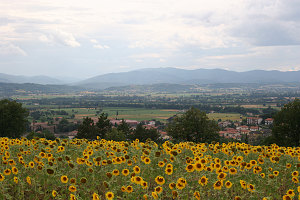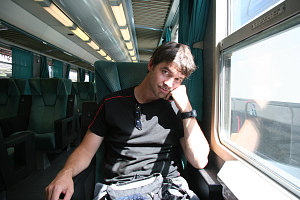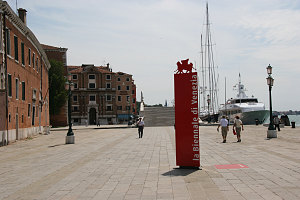
Umbrian Sunflowers
From Florence, we drove east, crossing through the province of Umbria. The route was pleasant, with kilometres of excellent twisty roads through medium-sized forested mountains. Umbria doesn't strike me as an especially densly-populated province.

Campsite, Lido di Dante
We reached the Adriatic coast near the town of Rimini, and turned north. We were looking for a nice, quiet sea-side campground to bed down for the night. Unfortunately, most of the coastline in the area was "strip" developed, with kilometres and kilometres of quasi-resort / rv-camperground development. And in the early evening hours, it was a zoo of traffic. So, we kept heading north, carefully looking at our map for possible out-of-the way spots along the coast.

Trolling for Shells
Fortunately, we did find more-or-less what we wanted in a little seaside hamlet called Lido di Dante. Instead of being served by a coastal road, you had to drive out to this spot on rural country road - perhaps that's why it was less busy. Anyway, it had a reasonable campground, and it was right next to the beach. It was nice to be next to the sea and water after spending a bunch of time inland, and the next morning we spent a couple of sunny hours on a fairly deserted beach, relaxing, swimming, and (for Jenn) picking up countless sea-shells.
Refreshed from our seaside stop, we continued north along coastal lowlands and lagoons towards the legendary city of Venice. We decided to stay in a motel or hotel on the coast just opposite Venice for convenience's sake and for the sake of a little extra comfort after 6 consecutive days of camping.

The Hotel Martello
The town just opposite Venice on the coast is called Maestre. We
drove the backstreets, looking for a reasonable place, and settled
upon a plain looking place called the 'Hotel Martello'. As it
turns out, we quite lucked out, since this little hotel turned
out to be very nice, even though it was only rated a two-star.
It was (a) quite reasonable in price ($70-something Euros, I
believe), (b) had very nice rooms, each custom decorated in an
elegant modern-european style, (c) had an excellent and complete
complimentary continental breakfast, and (d) had free high-speed
internet access. Also, the owner/operator was very helpful in
telling us to get into and out of Venice from the nearby train
station. This place is highly recommended. If you are interested,
the web site for the hotel is here
<http://www.hotelmartello.com>

Andrew commutes to Venice
Anyway, enough gushing about the hotel. Armed with good information on how to get into Venice easily (and for $1 Euro each!), we walked the 10 minutes over to the Maestra train stop and boarded a train for Venice. 15 minutes later we were deposited at the main train terminal in Venice, ready for an evening of exploration.
Venice is an amazing, timeless place. There is no sound of engines (well, except for boats), no wheeled vehicles (perhaps except for a dolly or two...). No bicycles, no cars - everything on foot. And the wonderful maze of narrow streets and waterways... winding between magnificently delapitated architecture; it is all quite intoxicating, and all extremely unique. Wandering around with only minimal help from the GPS (without it it would take me twice as long to get anywhere in Venice), we made it from the train station all the way to the Piazza San Marco. This time, unlike last time, Venice was not experiencing one of her high tides that flood the city, so we were able to walk in the dry for the whole time.
Having completed a scenic walking tour, we ducked into a restaurant just as a rain shower hit, and enjoyed a tasty meal.

Biennale Entrance
The next day we decided to remain and explore another unique aspect to Venice: The Biennale. The Biennale is a world-famous contemporary art and architecture exhibition that is held once every two years in Venice. Since we were lucky enough to be around during this, the 51st running of the exhibition, we decided to pay it a visit.
Retracing our train journey from the day before, we started off walking from the main train station in Venice. Rather than hire a water-taxi or take a water-bus, we decided to walk all of the way to the location of the exhibit, which was on the other side of Venice from the train station.
The Biennale is divided into two main sections: the Arsenale section contains all of the contemporary art exhibits of the exposition. The Arsenale itself are the buildings which made up the old shipyards and warehouses of the old Venetian Republic. The juxtaposition of the huge, old, semi-derelict buildings and the exhibitions of modern art within was quite artistic in itself.
The Arsenale's exhibits were indeed quite modern, quite interesting, and in places, controversial. The guerilla girls had several items on exhibit, all of them highlighting various aspects of women in today's world. There were many video exhibits, many depicting some sort of human conflict or tragedy. Jenn called these works 'angry art'. There were also many 'flights of fancy' type works that did not make any commentary on current world events or issues. All in all, quite interesting and varied.
Homeland Terror Alert for Women
After spending good few solid hours in the Arsenale, we walked over to the separate area (with signs glued to the streets guiding us!) that hosts the Giardini section. The Giardini section is where all of the country pavilions are located. The Giardini is a combination of architecture (the pavilions themselves) and, inside each paviliion, some sort of contemporary art done by a resident of that pavilion's country.
The variety and style of the different pavilions was huge. Each had a distinctive style, often related to the culture of the associated country. Within each pavilion the relationship to a country's culture was much less obvious, or even at times non-existant: We visited a russian wind-room, the british pavilion with its weird kaleidoscopic art, the canadian pavilion with its angry blood-splash-on-waterfall video thingy, and the Austrian pavilion with its lumber-and-shingle 'mountain' eveloping the building. There was quite a bit to see, too much to describe here. Some of the other pavilions had strange moving or powered exhibits, some had pure artwork, some had not much more than the building itself. It is all too much to describe here, but if you go to the Biennale-specific page that I have done up, you can see a much more complete set of images and descriptions.
We
were pretty tired as we neared the end of the country pavilions,
even skipping a few. We'd seen so much - our minds were overflowing
and not doing justice to any further artwork that we might come
across. One point is clear, though. The Biennale is truly a fascinating
art and architecture exhibition, and worth a visit if you are
lucky enough to be in Venice at the right time. (If
you are interesting in seeing a more in-depth set of pictures
of our visit to the Biennale,
click
here).
Time now to head back to our hotel after a very full day. We chose to walk back as far as the Piazza San Marco and take a water-bus back to the train station. This was an adventure in itself, waiting inside the bobbing 'floating bus stops' for a bus to arrive. Our boat-bus ride back to the train station gave us excellent views of the main waterline/skyline of Venice. What a beautiful and unique place!
(If you are interesting in seeing a more in-depth set of pictures
of our visit to Venice,
click
here.) Otherwise, to keep reading this narrative, select
the 'next page' button below.
[ Italy 2005 trip
home page |
The main trip report |
Family |
Monte Cervialto |
Herculaneum & Vesuvius |
Palace of Caserta |
Amalfi & Capri |
Abruzzo & Monte Amaro |
Rome |
Tuscany |
Venice |
The Biennale |
Via Ferrata-ing in the dolomites |
Climbing in the Ortles |
Gottfried's Adventures |
Maps, Graphs & GPS Data ]